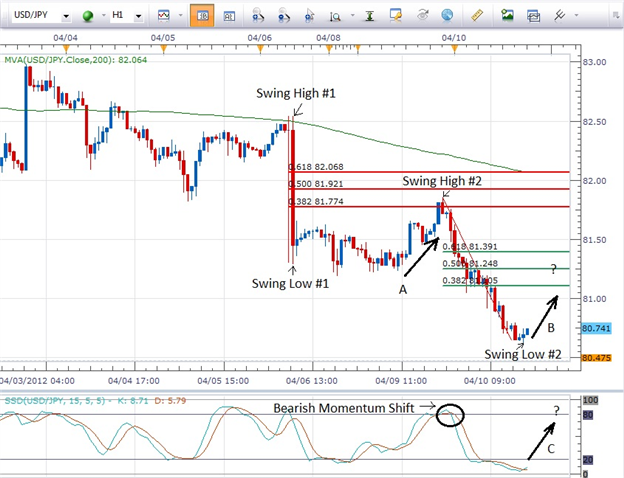Over the last week or so the USDJPY currency pair has been on a tear to the downside. Many traders who shorted the pair early on are now showing a nice profit. Traders who missed an entry however are now sitting on the sidelines, maybe kicking themselves, trying to figure out a way jump in on the move as it continues to the downside.
First of all, if you did miss the move, don’t beat yourself up. The very best traders out there will miss trades. It is simply a part of trading. Going forward in your trading career, there will be more trades that you catch and there will be more trades that you miss.
Next, just as you would not make a wild lunge to catch a falling knife (at least I hope you wouldn’t), don’t have a knee jerk reaction to try and “catch” a currency pair that is moving strongly to the downside.
When a pair is moving down strongly if we try to jump in along the way so as not to miss out, we run the very real risk of entering short just prior to a retracement. Since we know that a retracement will inevitably take place (we just don’t know when) why not wait until the retracement occurs and then short the pair after the retracement and lessen that particular risk?
Here’s what I like to do…
Let price action settle down a bit, retrace perhaps to a Fib level and then when momentum reinstates itself back in the direction of the initial move, I can re-enter.
Let’s take a look at the 1 hour chart of the USDJPY chart below…

The first strong move to the downside began at the point labeled Swing High #1 on the chart. As a trader, if I missed that move, I would draw a Fib Line from Swing High #1 to Swing Low #1 and wait for the pair to retrace to the area of the Fib levels noted in red.
In this instance the retracement did take place (arrow labeled “A” to Swing High #2) and I could have used Slow Stochastics to enter short when downside (bearish) momentum kicked back in...see the black circle. If a trader did not take part in that move, a new entry opportunity is setting up…
We draw a Fib line from Swing High #2 to Swing Low #2 and wait for price action to retrace (arrow labeled “B”) to a Fib level. Should that retracement take place, we could use Slow Stochastics to time our entry when bearish momentum reasserts itself.
Keep in mind that if a pair is trending strongly to the upside, the trading rationale outlined above will remain the same but the process will be reversed.
Bottom Line: a prudent trading strategy is to wait for the retracement cycle to take place as opposed to jumping in. Then, when the pair begins to move back in the direction of the trend, an entry can be made at that point.




